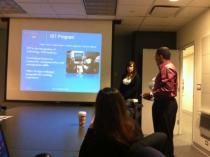Joseph Oakes, senior lecturer of information sciences and technology (IST) at Penn State Abington, likes to encourage his students to work on constructive technological projects, especially those providing a positive impact on society. True to his reputation, Oakes issued this challenge to students during a recent introduction to an IST class: Come up with creative ways to use global positioning system (GPS) technology to simplify peoples’ traveling experiences.
Running with the idea, one team of students suggested utilizing GPS technology to eliminate the need for EZ Pass monitors. The registered driver of a vehicle monitored by GPS would receive a periodic invoice for any travels on toll roads. The concept garnered so much praise from Oakes that the student team traveled to Harrisburg to present their idea to the Pennsylvania Turnpike Commission where it was well received.
Another project of collaboration between Oakes and his students involved GPS for public transportation -- the Rapid Transit Tracker (RTT).
“Their idea was to put kiosk screens in venues of public transportation so that the traveler could see what’s going on with the system, and then make adjustments to his/her travel plans,” said Oakes. “People would be able to stay abreast of their trip details such as whether or not their next bus or train is on time, or whether their current method of transportation is going faster and slower than expected. By knowing this information, people could make adjustments to their travel plans.”
During the spring semester, Oakes plans to work with his students on a practical project that involves adding an application to cellular devices which can monitor important health indicators, such as blood sugar levels and heart rate. Ultimately this application will be able to tell when the person’s body is not functioning normally and will then notify medical professionals for help.
“If you think about the lives that could be saved, it’s unbelievable. To be able to not only real-time capture vital stats, but capture it over a span of time, set up thresholds, communicate that integrated with other systems, to dispatch people or to call or text message somebody to get them there, that’s what we’re going to build next semester,” said Oakes.
According to Oakes, the projects for his first year students involve gathering information about the potential innovations, and then communicating that research through the use of videos, publications or PowerPoint presentations. Oakes explained that while working on these projects, there are many different aspects that students need to keep in mind.
“I try to get my students thinking, critical thinking. They have to solve a problem using technology. Is it feasible? Is it economical? What’s the human element? All these things factor into it.”
